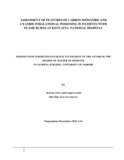| dc.contributor.author | Mackutwa, Edward M | |
| dc.date.accessioned | 2019-01-30T05:52:35Z | |
| dc.date.available | 2019-01-30T05:52:35Z | |
| dc.date.issued | 2018 | |
| dc.identifier.uri | http://hdl.handle.net/11295/105928 | |
| dc.description.abstract | Background & Justification of the Study
Patients with flame burns invariably inhale smoke but about 60% of those presenting to hospital
sustain heat or smoke inhalation that is significant to contribute to their morbidity and mortality. A
direct systemic effect of smoke inhalation is caused by inhalation of toxic gases during the
combustion of organic and inorganic substances. The two most common gases that contribute to
morbidity and mortality of flame burnt patients are carbon monoxide (CO) and cyanide (CN). These
two systemic inhaled toxicants cause many of the fire and smoke related acute deaths and should be
suspected in every fire victim.
The median mortality among admitted fire victims occurs at day 5 of admission. The bulk of early
deaths are attributable to burn shock and inhalational injuries. It is probable that among the causes
of these early deaths is inhaled smoke containing toxicants such as CO and CN whose measurement
was not being done in flame-burnt patients presenting to KNH. This gap was the basis of this study.
Aim & Objectives
To assess for features of carbon monoxide and cyanide inhalational poisoning in flame burnt
patients presenting to Kenyatta National Hospital.
Methodology
This was a prospective descriptive study. Eighty two consecutive non-pediatric consenting patients
presenting with acute (<24 hrs) flame burns were recruited into the study between April 2017 to
February 2018. Features of possible toxic smoke inhalational poisoning were assessed and
carboxyhemoglobin levels determined by a Masimo SETR Radical 57TM CO-oximeter system at
admission. Serum lactate levels were also determined by Siemens RapidPointR500 blood gas
analysis machine which was used as a surrogate marker for cyanide toxicity.
Data was analysed with Statistical Package for Social Sciences (SPSS) for Windows Version 21
with p value of <0.05 considered significant.
Study Shortcomings
Lactate levels were done only on 48% of the patients due to frequent unavailability of the service at
the concerned laboratory.
2 ©Mackutwa E.N., Postgraduate Dissertation 2018, UoN
Results
Eighty two subjects were recruited and after data cleaning, analysis was done on eighty. Most of the
subjects resided in estates considered low class. Fifty six percent were males and 44% were
females. Kerosene stove explosions contributed to most of the mechanisms of burns, at 28.7%. Over
53% of the material burnt by the fire was worn clothes only. Commonest complaints that could
point towards toxic inhalation was Confusion (n=23) and headache (n=21). Seventy percent (n=56)
of the respondents had singed nasal vibrissae and 25% had upper airway hyperemia or edema
which pointed towards likelihood of significant inhalational injury. The mean TBSA was 30.9% and
average SPCO% was 5.48%. Average Arterial lactate was 2.91mmol/L. Overall mortality was
38.7% out of which 22% occurred in less than 24 hours after admission. Factors found to have
positive correlation with death included upper airway edema/hyperemia (p=0.024), %TBSA
(p=0.01), lactate (p=0.01) and Base deficit (p=0.01); but not SPCO% (p=0.708).
Discussion
Rampant use of open flames for household cooking and lighting by most of the subjects who
resided in relatively low class houses where precaution to fire outbreaks may not be taken may have
contributed to the flame injuries. The, mean SPCO% of 5.48% fell below levels that would cause
symptoms hence may not have accounted for the confusion and headache seen in over one third of
the subjects neither could it account for the morbidity/mortality because it was below toxic levels.
In those whom lactate levels were measured, only 7 had lactate levels of >5mmol/L. However, this
level was far below 10mmol/L, which is the threshold to suspect cyanide poisoning in acute burns.
Therefore, the 22% of all deaths that occurred before 24 hours of admission may be attributed to
well-known factors that cause acute deaths of burn patients such as burn shock and inhalational
injury. There may have been little or no contribution by CO and CN inhalation.
Conclusion and Recommendations
A large proportion of flame burnt patients presenting acutely to KNH have symptoms that are seen
in CO or CN inhalational poisoning. However, due to low SpCO% and low lactate levels in
majority of them, these symptoms are considered nonspecific for toxic inhalational poisoning.
Therefore CO and CN may not be a significant factor in their poor outcomes as hypothesized in this
study. Nonetheless, many of these patients have significant inhalational injury which has a strong
positive correlation to their deaths and hence would still require early high flow oxygen
administration and probable tracheal intubation. | en_US |
| dc.language.iso | en | en_US |
| dc.publisher | University of Nairobi | en_US |
| dc.rights | Attribution-NonCommercial-NoDerivs 3.0 United States | * |
| dc.rights.uri | http://creativecommons.org/licenses/by-nc-nd/3.0/us/ | * |
| dc.subject | Assessment of Features of Carbon Monoxide and Cyanide Inhalation Poisoning | en_US |
| dc.title | Assessment of Features of Carbon Monoxide and Cyanide Inhalation Poisoning in Patients With Flame Burns at Kenyatta National Hospital | en_US |
| dc.type | Thesis | en_US |
| dc.description.department | a
Department of Psychiatry, University of Nairobi, ; bDepartment of Mental Health, School of Medicine,
Moi University, Eldoret, Kenya | |



